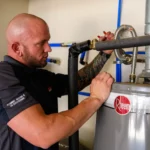Last Updated on December 25, 2025 by Rida Gul
In the world of manufacturing and electrical engineering, coil-winding technology plays a critical role in producing various electronic components. From transformers and motors to sensors and inductors, coil winding is essential for creating efficient and reliable electromagnetic devices. As technology evolves, so does the field of coil winding, with advancements paving the way for more precise, efficient, and versatile manufacturing processes. In this article, we’ll explore the transformative trends shaping the future of coil-winding technology.
Table of Contents
Evolution of Coil-Winding Machines
Coil-winding machines have undergone significant transformations over the decades. These machines are designed to automate the process of winding wire onto a core to create coils used in various electrical components. The early iterations of coil-winding machines were relatively basic, relying on manual or semi-automatic operation. However, modern automation, robotics, and materials science advancements have revolutionized coil-winding technology.
Automation and Robotics
One of the most notable trends in coil-winding technology is the increasing integration of automation and robotics. Today’s coil-winding machines are highly automated and capable of performing complex winding patterns with minimal human intervention. Automated systems improve efficiency, precision, and consistency in coil production. Robots can handle intricate wire paths and achieve tight tolerances, resulting in higher-quality coils for demanding applications.
CNC Control and Programming
Computer Numerical Control (CNC) has become commonplace in advanced coil-winding machines. CNC technology allows for precise control over winding parameters such as speed, tension, and layering. Operators can program intricate winding patterns directly into the machine, enabling the production of custom coils tailored to specific electrical requirements. This flexibility is invaluable in industries where unique coil designs are necessary for optimal performance.
Advanced Materials and Wire Handling
The choice of materials and wires used in coil winding has also evolved. Modern coil-winding machines can handle a wide range of materials, including exotic alloys and ultrafine wires. This flexibility opens up new possibilities for miniaturization and efficiency in coil design. Additionally, advancements in insulation materials have improved the durability and thermal performance of coils, extending their lifespan in demanding environments.
Key Trends Shaping the Future
Looking ahead, several key trends are expected to shape the future landscape of coil-winding technology:
Additive Manufacturing (3D Printing)
The integration of additive manufacturing techniques with coil winding holds immense promise. Researchers are exploring ways to 3D print coil structures directly, allowing for unprecedented geometries and performance characteristics. This approach could revolutionize the design and manufacturing of electromagnetic devices, enabling novel applications in areas such as aerospace, healthcare, and renewable energy.
Industry 4.0 and IoT Integration
Coil-winding machines are increasingly becoming part of interconnected manufacturing ecosystems enabled by Industry 4.0 principles. These smart factories leverage IoT (Internet of Things) devices to collect real-time data on machine performance, material usage, and product quality. Predictive maintenance algorithms can anticipate machine failures, minimizing downtime and optimizing production efficiency.
Green Technologies and Sustainability
The drive towards sustainability is influencing coil-winding technology. Manufacturers are exploring eco-friendly materials and processes to reduce environmental impact. This includes recycling winding wire and optimizing energy consumption during production. Sustainable coil-winding practices align with global efforts to minimize industry waste and carbon footprint.
AI and Machine Learning
Artificial Intelligence (AI) and Machine Learning (ML) are poised to enhance coil-winding processes further. These technologies can analyze vast datasets to optimize winding parameters for maximum efficiency and performance. AI-powered quality control systems can detect defects in real time, ensuring that every coil meets stringent quality standards.
Applications and Impact
The transformative trends in coil-winding technology have far-reaching implications across industries:
Automotive and Transportation
Advances in coil winding are crucial for electric and hybrid vehicles (EVs). High-efficiency motors and transformers rely on precision-wound coils to maximize performance and energy efficiency. Improved coil designs contribute to the electrification of transportation, reducing reliance on fossil fuels.
Renewable Energy
Reliable coils are essential for converting and distributing electrical power in renewable energy systems such as wind turbines and solar inverters. Advanced coil-winding technology enables higher power densities and improved reliability in renewable energy infrastructure.
Consumer Electronics
From smartphones to household appliances, consumer electronics benefit from miniaturized coils produced using cutting-edge winding techniques. This enables sleeker designs and enhanced functionality in everyday devices.
Conclusion
The future of coil-winding technology is bright, driven by innovation, and fueled by the demand for smarter, more efficient electrical components. As industries continue to evolve, so will the capabilities of coil-winding machines, pushing the boundaries of what is possible in electromagnetic design and manufacturing. By embracing transformative trends such as automation, additive manufacturing, and sustainable practices, the coil-winding industry is poised to play a pivotal role in shaping the technologies of tomorrow.
In summary, coil-winding machines are at the forefront of technological innovation, enabling the creation of sophisticated coils that power our modern world. With each advancement, from AI-driven optimization to 3D-printed coils, the future of coil-winding technology promises to be transformative, opening doors to new applications and efficiencies across diverse sectors. As we continue to push the boundaries of what is achievable, the evolution of coil-winding machines will undoubtedly profoundly impact how we harness and utilize electromagnetic energy.
Apart from this, if you are interested to know more about Is Duct Cleaning a Waste of Money? then visit our Technology category.



























